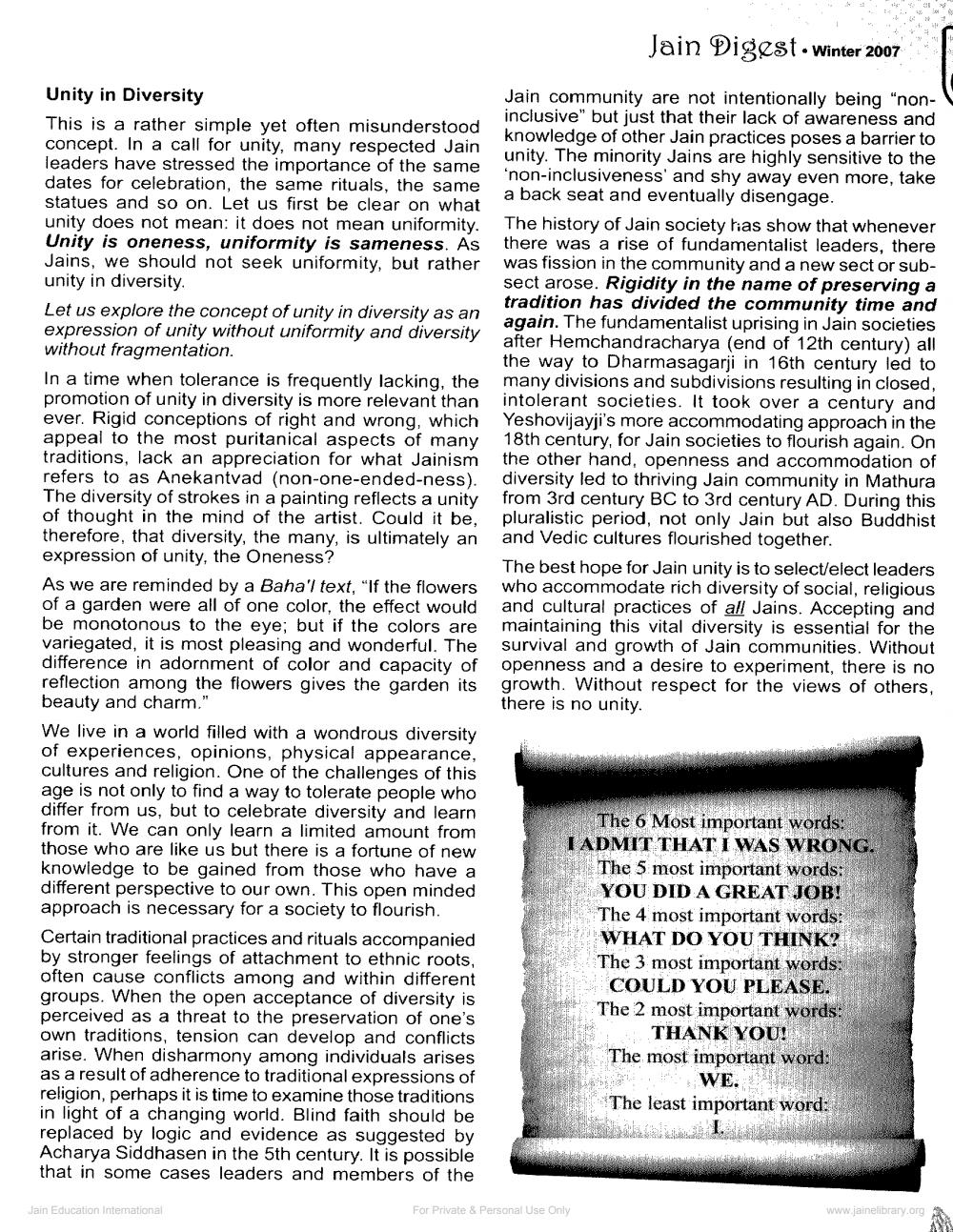Book Title: Jain Digest 2007 11 2 Author(s): Federation of JAINA Publisher: USA Federation of JAINA View full book textPage 7
________________ Jain Digest. Winter 2007 Unity in Diversity Jain community are not intentionally being "non inclusive" but just that their lack of awareness and This is a rather simple yet often misunderstood knowledge of other Jain practices poses a barrier to concept. In a call for unity, many respected Jain unity. The minority Jains are highly sensitive to the leaders have stressed the importance of the same dates for celebration, the same rituals, the same 'non-inclusiveness' and shy away even more, take a back seat and eventually disengage. statues and so on. Let us first be clear on what unity does not mean: it does not mean uniformity. The history of Jain society has show that whenever Unity is oneness, uniformity is sameness. As there was a rise of fundamentalist leaders, there Jains, we should not seek uniformity, but rather was fission in the community and a new sect or subunity in diversity. sect arose. Rigidity in the name of preserving a tradition has divided the community time and Let us explore the concept of unity in diversity as an again. The fundamentalist uprising in Jain societies expression of unity without uniformity and diversity after Hemchandracharya (end of 12th century) all without fragmentation. the way to Dharmasagarji in 16th century led to In a time when tolerance is frequently lacking, the many divisions and subdivisions resulting in closed, promotion of unity in diversity is more relevant than intolerant societies. It took over a century and ever. Rigid conceptions of right and wrong, which Yeshovijayji's more accommodating approach in the appeal to the most puritanical aspects of many 18th century, for Jain societies to flourish again. On traditions, lack an appreciation for what Jainism the other hand, openness and accommodation of refers to as Anekantvad (non-one-ended-ness). diversity led to thriving Jain community in Mathura The diversity of strokes in a painting reflects a unity from 3rd century BC to 3rd century AD. During this of thought in the mind of the artist. Could it be. pluralistic period, not only Jain but also Buddhist therefore, that diversity, the many, is ultimately an and Vedic cultures flourished together. expression of unity, the Oneness? The best hope for Jain unity is to select/elect leaders As we are reminded by a Baha'l text, "If the flowers who accommodate rich diversity of social, religious of a garden were all of one color, the effect would and cultural practices of all Jains. Accepting and be monotonous to the eye; but if the colors are maintaining this vital diversity is essential for the variegated, it is most pleasing and wonderful. The survival and growth of Jain communities. Without difference in adornment of color and capacity of openness and a desire to experiment, there is no reflection among the flowers gives the garden its growth. Without respect for the views of others, beauty and charm." there is no unity. We live in a world filled with a wondrous diversity of experiences, opinions, physical appearance, cultures and religion. One of the challenges of this age is not only to find a way to tolerate people who differ from us, but to celebrate diversity and learn The 6 Most important words: from it. We can only learn a limited amount from those who are like us but there is a fortune of new ADMIT THAT I WAS WRONG. knowledge to be gained from those who have a The 5 most important words: different perspective to our own. This open minded YOU DID A GREAT JOB! approach is necessary for a society to flourish. The 4 most important words: Certain traditional practices and rituals accompanied WHAT DO YOU THINK? by stronger feelings of attachment to ethnic roots, The 3 most important words: often cause conflicts among and within different COULD YOU PLEASE. groups. When the open acceptance of diversity is The 2 most important words: perceived as a threat to the preservation of one's own traditions, tension can develop and conflicts THANK YOU! arise. When disharmony among individuals arises The most important word: as a result of adherence to traditional expressions of HAWE. religion, perhaps it is time to examine those traditions The least important word: in light of a changing world. Blind faith should be replaced by logic and evidence as suggested by Acharya Siddhasen in the 5th century. It is possible that in some cases leaders and members of the Jain Education Intemational For Private & Personal Use Only www.jainelibrary.orgPage Navigation
1 ... 5 6 7 8 9 10 11 12 13 14 15 16 17 18 19 20 21 22 23 24 25 26 27 28 29 30 31 32 33 34 35 36 37 38 39 40
